

“Portraits of the Passion: The Crucifixion”
Matthew 27:33-44
Pastor Kevin Vogts
Trinity Lutheran Church
Paola, Kansas
Lent Service IV—March 18, 2020
In the Name of the Father and of the Son and of the Holy
Spirit. Amen.
Our Lenten sermon series this year is “Portraits of the Passion,” the
Lenten story illustrated with slides of artworks from the Nelson-Atkins Museum
and Spencer Museum of Art at the University of Kansas.
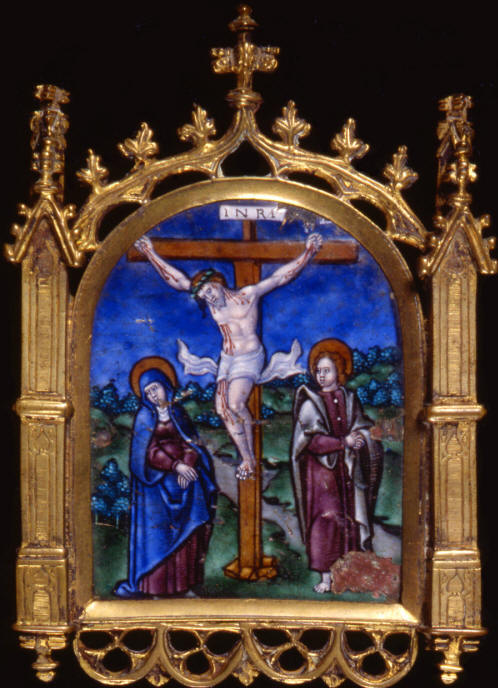
“Pax with the Crucifixion”
French – c. 1550 – Enamel with Gilt Bronze Frame
Among the artworks on display in these museums, the one image that you
will find more often than any other is “The Crucifixion.” And, indeed, art
historians will tell you that among all the artworks ever created in the entire
history of the whole world, “The Crucifixion” of Jesus Christ is the one image
that has been portrayed far more often than any other.
The question is: Why? His crucifixion does not stand out because
crucifixions were rare in the ancient world. Hundreds of thousands of
other people besides Jesus of Nazareth were crucified by the Romans and other
ancient empires. And, doesn’t a crucifixion seem like an awfully odd image
to become humanity’s all-time favorite anyway? It is, after all, nothing
other than the most brutal form of execution ever devised by wicked humankind.
So, why has this one particular crucifixion, of Jesus of Nazareth, become so
revered by us?
Peter explains the unique significance of this particular crucifixion:
“He himself bore our sins in his body on the cross.” Paul says, “God
presented him as a sacrifice of atonement, through faith in his blood.”
At the place in Jerusalem where tradition says Christ was crucified,
which is now inside a chapel, there is an inscription in the floor: “This Is the
Center of the Universe.” It is 40 years ago this year that I stood in that
chapel on Good Friday, and reading that mystical inscription brought tears to my
eyes. For, it is so true that what happened on Mt. Calvary is the central
event in the history, not just of Christianity or western civilization, but the
central event of the history of the whole world, yes the whole universe.
By his death on that cross that day, God’s own Son sacrificed himself to pay for
the sins of all humanity, including your sins and mine. Because of his
sacrifice, your sins are all forgiven, you are at peace with God through his
blood, shed on the cross.
This exquisite French enamel plaque from the 1500’s on display at the
Spencer Museum is actually only about three inches square. You may have
been to churches were the minister and people exchange a kiss of peace, often
substituted with a handshake, before receiving Holy Communion. You may
have also heard in the news lately that because of the current virus outbreak
many churches have temporarily discontinued this practice or substituted
something like an elbow bump.
The outbreak we are currently enduring is certainly something none of
us has ever experienced before, but actually it’s not unprecedented in the
history of the world. For, during the Middle Ages this enamel plaque was
their substitute for the kiss of peace when plagues ravaged Europe. It is called
a Pax, the Latin word for peace. Rather than “passing the peace” by
kissing each other, the minister and congregation would exchange their kiss of
peace by passing around and all kissing this plaque. You see, they knew
enough not to pass on the plague by kissing each other, but they didn’t
understand germ transmission, and realize that having everyone pass around and
kiss this plaque instead was just as bad or worse.*
Standing next to the cross are Jesus’ mother, Mary, and the Apostle
John. In a very personal passage in his Gospel, John himself remembers how
from the cross Jesus committed his mother Mary into John’s care: “Near the cross
of Jesus stood his mother . . . When Jesus saw his mother there, and the
disciple whom he loved standing nearby, he said to his mother, ‘Woman, behold
your son,’ and to the disciple, ‘Behold your mother.’ From that time on, this
disciple took her into his home.”
Above Christ is a placard with the letters “INRI.” After a person
was condemned to be crucified, a placard like this, called a “titulus,” would be
prepared stating the crime for which he was being executed. Mark describes
it as, “The written notice of the charge against him.” It would be carried
before the condemned man as he was paraded out carrying his cross to the place
of execution and then be posted there, as a warning to all not to commit this
same crime.
John reports, “Pilate had a notice prepared and fastened to the cross.
It read: JESUS OF NAZARETH, THE KING OF THE JEWS. Many of the Jews read
this sign, for the place where Jesus was crucified was near the city, and the
sign was written in Aramaic, Latin and Greek.” Matthew says, “Above his
head they placed the written charge against him.”
“INRI” are the initials for the Latin phrase, “Iesus Nazeranus Rex
Iudiorum,” “Jesus of Nazareth, the King of the Jews.” This was the
official charge against him. His false accusers had said, “Anyone who
claims to be a king opposes Caesar,” and although Jesus explained to Pilate, “My
kingdom is not of this world,” he was officially—although wrongly—executed for
rebellion against the Roman Empire.
Psalm 22 which we read earlier prophesied, “They have pierced my hands
and my feet.” We see in this beautiful enamel blood spurting forth from
the five wounds of Christ, where his hands and feet were nailed to the cross,
and his side where he was pierced after his death. As “doubting” Thomas
said, “Unless I see the nail marks in his hands and put my finger where the
nails were, and put my hand into his side, I will not believe it.”
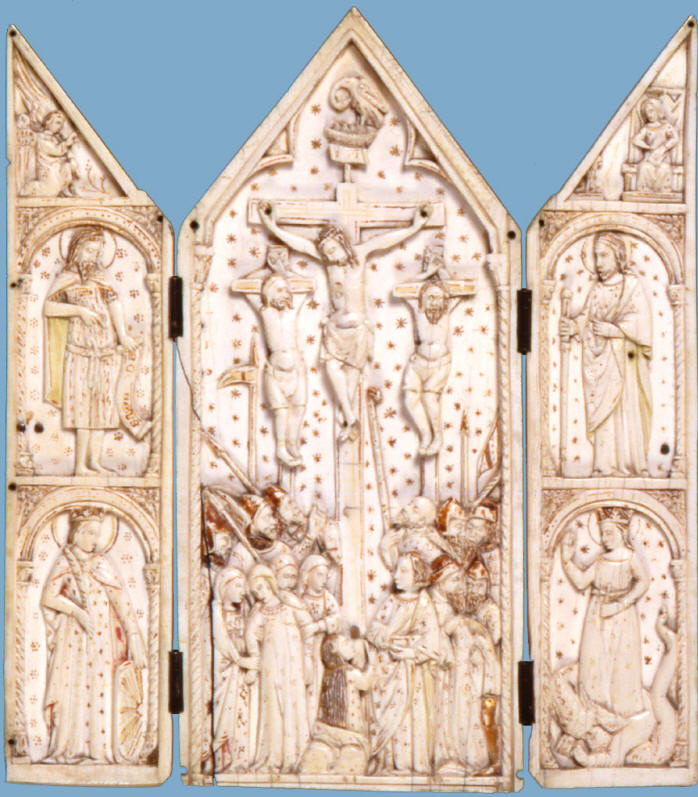
“Triptych with the
Crucifixion and Four Saints”
Bologna, Italy – 1400’s – Ivory with Traces of Polychrome & Gilding
This Italian Ivory triptych from the 1400’s is also
very small, about foot tall. The side panels with four saints fold in, and
it was designed to be a portable shrine for use in private devotions.
In this triptych there is something very surprising, and at first
glance rather bizarre, perched on top of the cross. A pelican has built a nest
there, and is feeding her young. What in the world could THAT mean?
A pelican feeding her young is actually an ancient Christian symbol, called “The
Pelican in Her Piety.” It is based on the fact that a pelican, if
necessary, will pluck open her breast to feed her young with her own blood.
In the same way, our Savior shed his own blood to give us eternal life, and he
feeds with his own body and blood in the Sacrament of Holy Communion.
I have to think about the person 500 years ago who used this triptych
for private devotions, whom I’m sure understood the unusual symbolism of “The
Pelican in Her Piety” atop the cross. Maybe that person requested this as
part the triptych, perhaps it was one of his or her favorite symbols.
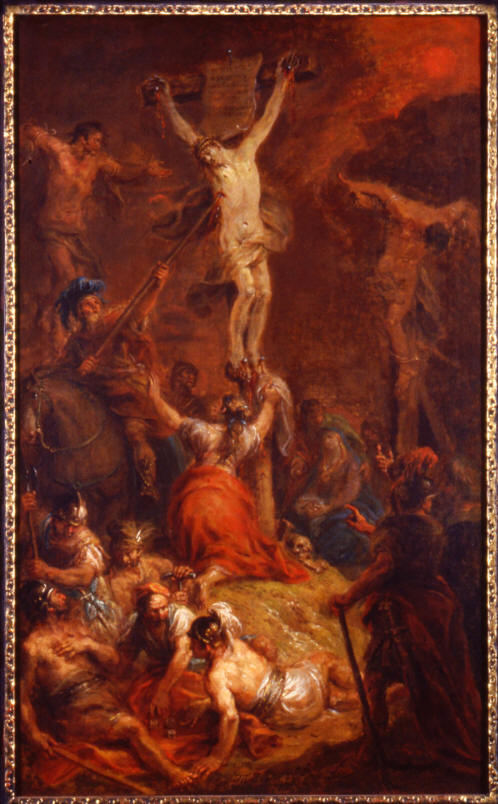
“Crucifixion”
Johann Martin Kremser-Schmidt – c. 1797 – Oil on Canvas
This Austrian oil painting from about 1800 is very dark, reflecting the
extraordinary darkness that veiled the world as Christ hung on the cross from
noon to 3:00pm, as Mark reports, “At the sixth hour darkness came over the whole
land until the ninth hour.” Jesus is crucified between two criminals, as
Luke reports, “When they came to the place called the Skull, there they
crucified him, along with the criminals—one on his right, the other on his
left.”
The heartless soldiers are portrayed shamefully playing dice while the
Son of God suffers and dies for the sins of the world. They are really
symbolic of the shameful preoccupation of all mankind with wicked pursuits
instead of the Lord’s will.
As in many portrayals of the crucifixion, there is a skull at the base
of the cross. The reflects the name of the place of crucifixion,
“Golgotha” or “Calvary,” which mean “The Place of the Skull.” But, the
skull at the base of the cross also symbolizes that by the cross Christ
triumphed over death for you and all who trust in him. As Paul says, “Our
Savior Jesus Christ has abolished death and brought life and immortality to
light through the gospel. . . The last enemy to be destroyed is death.”
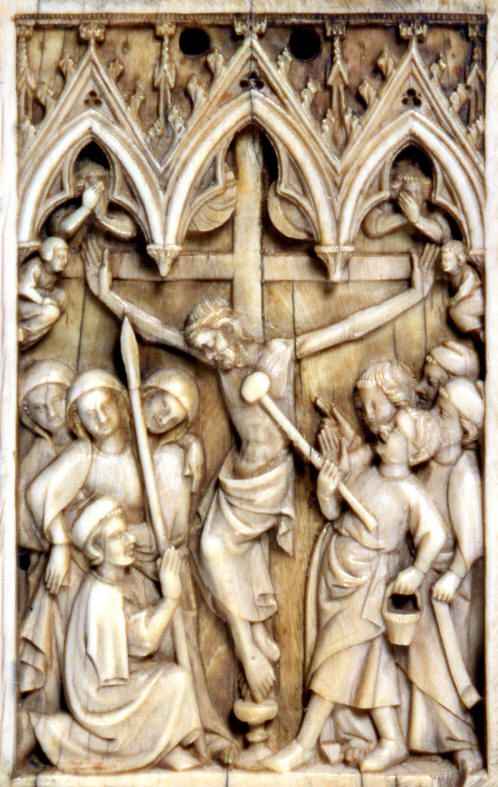
“Plaque with the Crucifixion”
French – 1300’s – Ivory
This French Ivory plaque from the 1300’s is about eight inches tall.
It was once part of a diptych, two panels that would fold together, and was also
used for private devotions.
At the base of the cross in many of these artworks are two groups: The
soldiers who crucified Jesus; and his mother along with his closest female
followers, as Mark notes, “Many women were there, watching from a distance. They
had followed Jesus from Galilee to care for his needs.”
The stick and bucket held by one of the soldiers reflects John’s
report, “Jesus said, ‘I thirst.’ A jar of wine vinegar was there, so they
soaked a sponge in it, put the sponge on a stalk of the hyssop plant, and lifted
it to Jesus’ lips.” A poignant imagery in this plaque, that is found in
many classic portrayals of the crucifixion, is angels who are hiding their faces
from the horrible sight of their Lord being crucified.
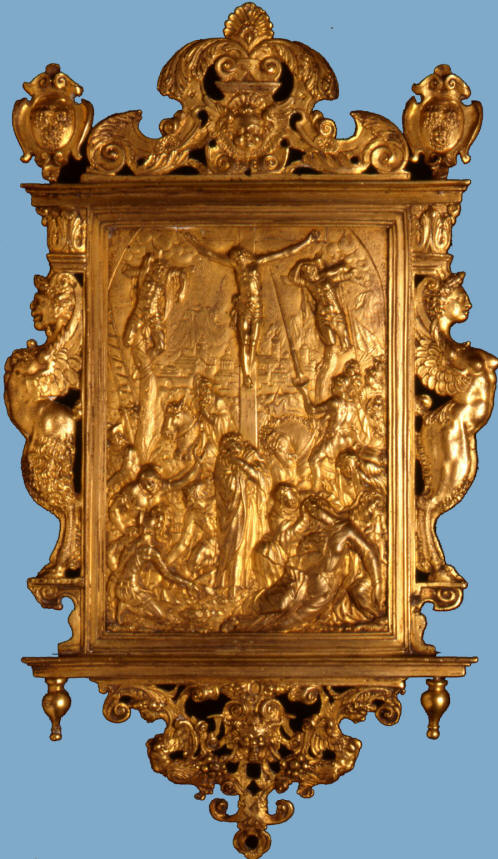
“Crucifixion”
Hans von Aachen – c. 1575 – Gilt Bronze
John reports, “The soldiers came and broke the legs of the first man
who had been crucified with Jesus, and then those of the other.” It was
common to break the legs of crucifixion victims in order to hasten their deaths.
In this German gilded bronze plaque from the 1500’s the two thieves on either
side of Jesus have had their legs broken.
John continues, “But when they came to Jesus and found that he was
already dead, they did not break his legs. Instead, one of the soldiers
pierced Jesus’ side with a spear, bringing a sudden flow of blood and water.”
Modern medical doctors interpret this to mean that Jesus probably died as a
result of congestive heart failure, a buildup of fluids around the heart.
Quoting the Old Testament, John says, “These things happened so that the
scripture would be fulfilled: ‘Not one of his bones will be broken,’ and, as
another scripture says, ‘They will look on the one they have pierced.’”
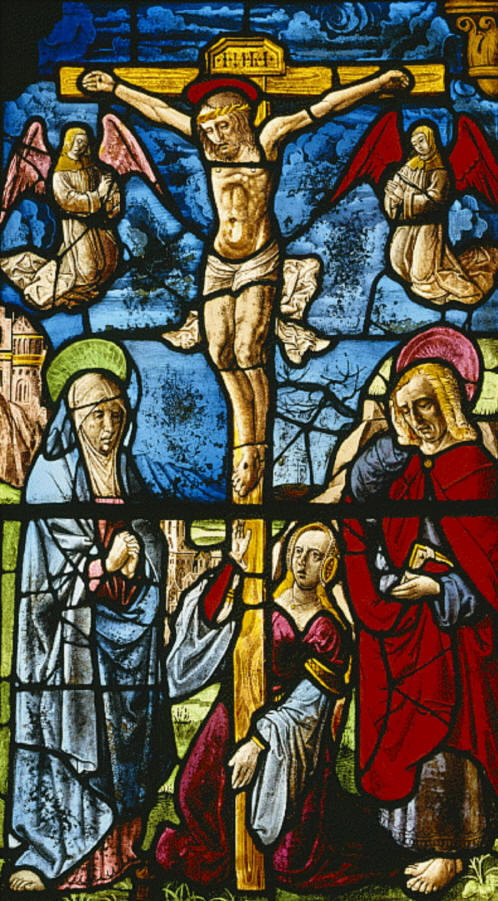
“The Crucifixion”
French – 1470 – Stained Glass
Probably the most common medium for Christian artwork, still today, is
windows made of stained glass. It was during the Middle Ages that stained glass
was invented, as in this French example from the 1400’s on display at the
Nelson-Atkins Museum.
The hymn “How Great Thou Art” expresses the significance of “The
Crucifixion”:
But when I think that God, His Son not sparing,
Sent Him to die, I scarce can take it in,
That on the cross my burden gladly bearing
He bled and died to take away my sin.
Return to Top | Return to Sermons | Home | Email Church Office